
Ageratina altissima, also known as white snakeroot, richweed, or white sanicle, is a poisonous perennial herb in the family Asteraceae, native to eastern and central North America. An older binomial name for this species is Eupatorium rugosum, but the genus Eupatorium has undergone taxonomic revision by botanists, and a number of the species that were once included in it have been moved to other genera.
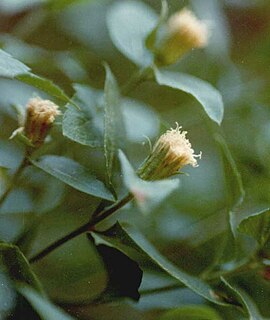
Ageratina shastensis is a species of snakeroot which is endemic to Shasta County, California. It is known by the common names Mt. Shasta snakeroot and Shasta eupatorium.
Ageratina cuencana is a species of flowering plant in the aster family. It is endemic to Ecuador. Its natural habitats are subtropical or tropical moist montane forests and subtropical or tropical high-altitude shrubland. It is threatened by habitat loss.
Ageratina macbridei is a species of flowering plant in the aster family. It is endemic to Peru, where it occurs in several types of habitats, often near rivers.
Ageratina rhypodes is a species of flowering plant in the sunflower family. It is found only in Ecuador. Its natural habitats are subtropical or tropical moist montane forests and subtropical or tropical high-altitude grassland. It is threatened by habitat loss.
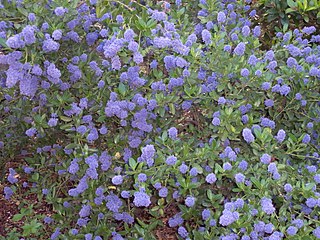
Ceanothus thyrsiflorus, known as blueblossom or blue blossom ceanothus, is an evergreen shrub in the buckthorn family Rhamnaceae that is endemic to Oregon and California in the US. The term 'Californian lilac' is also applied to this and other varieties of ceanothus, though it is not closely related to Syringa, the true lilac.

Ageratina riparia, commonly known as mistflower or creeping croftonweed, is a species of flowering plant in the aster family, native to Mexico, Cuba and Jamaica.

Ageratina herbacea is a North American species of flowering plants in the daisy family known by the common names fragrant snakeroot and Apache snakeroot. It is native to desert regions of the southwestern United States and northern Mexico. It grows in rocky slopes in conifer forests and woodlands.
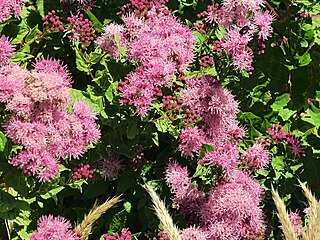
Ageratina occidentalis is a species of flowering plant in the daisy family known by the common name western snakeroot or western eupatorium. It is native to the western United States where it grows in several types of habitat. It is found in California, Oregon, Washington, Idaho, Montana, Nevada, and Utah.

Ageratina adenophora, commonly known as Crofton weed, is a species of flowering plant in the daisy family native to Mexico and Central America. Originally grown as an ornamental plant, it has become invasive into farmland and bushland worldwide. It is toxic to horses, who develop a respiratory disease known as Numinbah Horse Sickness after eating it.
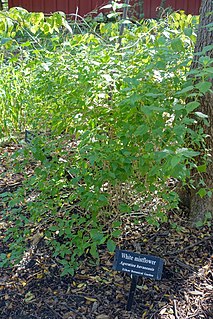
Ageratina havanensis, the Havana snakeroot or white mistflower, is a species of flowering shrub in the sunflower family, native to Texas, Cuba, and northeastern and east-central Mexico. Unlike many other species of Ageratina, it is evergreen.
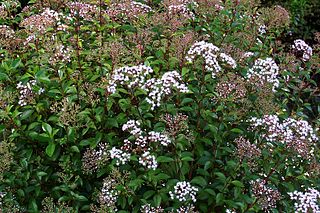
Ageratina ligustrina(privet-leaved ageratina, privet-leaved snakeroot), is Mesoamerican species of evergreen flowering shrub in the sunflower family. It is widespread across much of Mexico and Central America from Tamaulipas to Costa Rica.

Ageratina luciae-brauniae is a species of flowering plant in the aster family known by the common names Lucy Braun's snakeroot and rockhouse white snakeroot. It is native to the eastern United States, where it is limited to the Cumberland Plateau of Kentucky and Tennessee. It may also occur in South Carolina but these reports are unconfirmed.
Ageratina concordiana is a species of flowering shrub in the sunflower family, native to the state of Sinaloa in northwestern Mexico.
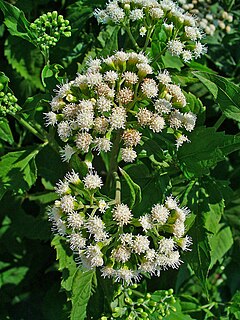
Ageratina aromatica, also known as lesser snakeroot and small-leaved white snakeroot, is a North American species of plants in the sunflower family. It is widespread and common across much of the eastern and southern United States from Louisiana to Massachusetts, as far inland as Kentucky and Ohio.
Ageratina jucunda, called the Hammock snakeroot, is a North American species of plants in the sunflower family. It is found only in the southeastern United States, in the states of Georgia and Florida.
Ageratina lemmonii, called the Lemmon's snakeroot, is a North American species of plants in the sunflower family. It is found only in the southwestern United States in the states of Arizona and New Mexico, as well as the states of Sonora, Sinaloa, Chihuahua and Durango in Mexico.
Ageratina paupercula, called the Santa Rita snakeroot, is a North American species of shrubs or perennial herbs in the sunflower family. It is found only in the states of Arizona, Sonora, Chihuahua, Durango, Nayarit, and Jalisco.
Ageratina rothrockii is a North American species of plants in the sunflower family. It is found only in the southwestern United States in the states of Arizona, New Mexico, and Texas, as well as the states of Sonora, Coahuila, Chihuahua, and Durango in Mexico.
Ageratina wrightii is a North American species of plants in the sunflower family. It is native to the southwestern United States and northern Mexico.










